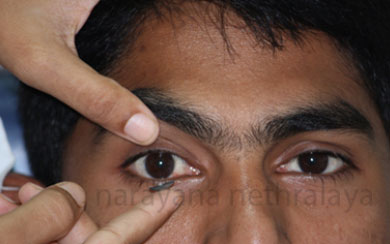

The contact lens department at Vyawahare Netralaya is well equipped to cater the requirements of all eye conditions.We provide basic and various speciality contact lenses. The basic contact lenses like Spherical soft lenses, Rigid Gas Permeable lenses and Toric lenses are available which can be given in patient’s who wish to avoid glasses due to cosmetic purpose or due to the profession itself. Also, the Cosmetic contact lenses, which enables one to enhance or change the eye colour are available with us.
In the early stages, vision can be corrected with glasses or regular soft contact but as KC progresses they are not able to correct the distortion caused by the irregular corneal surface and more complex contact lens designs are required.
 The role of soft lenses in keratoconus is limited because the soft lens drapes over the irregular corneal surface and the front surface of the lens assumes the same irregular surface as the cornea without trapping a fluid reservoir so the effective refracting surface is no improvement over the original corneal surface. There are some specially designed thicker soft lenses retain more of a rigid shape and may contribute to the liquid lens effect to some extent. There are designs being used for keratoconus, and they are helpful in mild to moderate cases.
The role of soft lenses in keratoconus is limited because the soft lens drapes over the irregular corneal surface and the front surface of the lens assumes the same irregular surface as the cornea without trapping a fluid reservoir so the effective refracting surface is no improvement over the original corneal surface. There are some specially designed thicker soft lenses retain more of a rigid shape and may contribute to the liquid lens effect to some extent. There are designs being used for keratoconus, and they are helpful in mild to moderate cases.
They consist of: A daily cleaner, to remove tear film oils, mucus, cosmetics, and other debris from lens surfaces. Cleaning solution containers have a red tip to warn patients that the solution should not be put in the eyes. If cleaner is accidentally instilled in the eyes, it should be flushed out immediately, preferably by dunking the entire face into a sink filled with water.
A combination wetting/soaking solution for lens storage and reinsertion in the eye, which kills bacteria and other microorganisms, keeps lenses from warping, and acts as a “cushioning agent” when the lenses are placed in the eyes. An optional enzymatic cleaner (in either liquid or tablet form), for patients who build up a lot of protein on their lenses. Not all rigid lens wearers need an enzymatic cleaner.
A lubricating and rewetting drop, to instill in the eye while you are wearing lenses. This will help to flush debris from under the lenses and help the lenses to glide more smoothly and comfortably in the eyes. Rub the lens between your fingers! It may warp or crack! If the lens curvature is too steep for your index finger to clean the inner lens surface, try using your pinkie or a cotton swab. Rinse the lens with cool or lukewarm water. Hot water will warp the lens. Do not rinse your lenses over an open drain! Replace the right lens in the case and repeat the steps for your left lens. Soak lenses overnight or for at least 4 hours. In the morning, wash your hands and insert your lenses directly from the wetting/soaking or conditioning solution. Do not rinse first! The solution will help to cushion the lenses as you insert them. In addition, if the lenses are rinsed with water after they have been disinfected, there is a chance that they may become contaminated from impurities in the water supply.
Clean your lenses at night, immediately after you remove them from your eyes. Leaving them in the soaking solution without cleaning until morning reduces the effectiveness of the disinfecting chemicals. In addition, rinsing the cleaner off with tap water just prior to replacing the lenses in your eyes might introduce bacteria or other microorganisms that would ordinarily have been killed while the lenses soaked overnight.
If your lenses ever dry out, soak them for at least 4 hours before you wear them again, since they may have warped or flattened in curvature when the liquid evaporated. Do not mix and match solutions made by different manufacturers. Doing so may cloud your lenses, cause them to become gummy, or irritate your eyes. Make sure that the cleaning, soaking, disinfecting, and wetting/rewetting products you buy are all part of the same care system.
Always store your lenses in a case with ridges on the bottom. Lenses tend to suction onto smooth-bottomed cases and may chip if you try to pry them up at the edges. Replace your case each time you buy a new bottle of wetting/soaking or cleaning/soaking solution. Cases tend to become contaminated. You can clean case with your contact lens cleaner using a brand new inexpensive toothbrush. Be sure to rinse the case well before using it again.
If the skin on your hands is rough, ask your contact lens fitter if you can use a manually-agitated device such as the Allergan Hydramat or a mechanical device such as the Clensatron. These devices work like miniature washing machines and may protect the lenses from becoming scratched from your rough skin.
If you remove your lenses with a suction cup make sure you know exactly where the lens is before placing the suction cup on the eye. Suction cups should be cleaned with contact lens cleaner and rinsed after each use. They can also be soaked in wetting/soaking or cleaning/soaking solution. If you drop a lens, do not drag it along a surface. Wet your finger with wetting/soaking or rewetting solution and touch it gently to the lens to lift it.